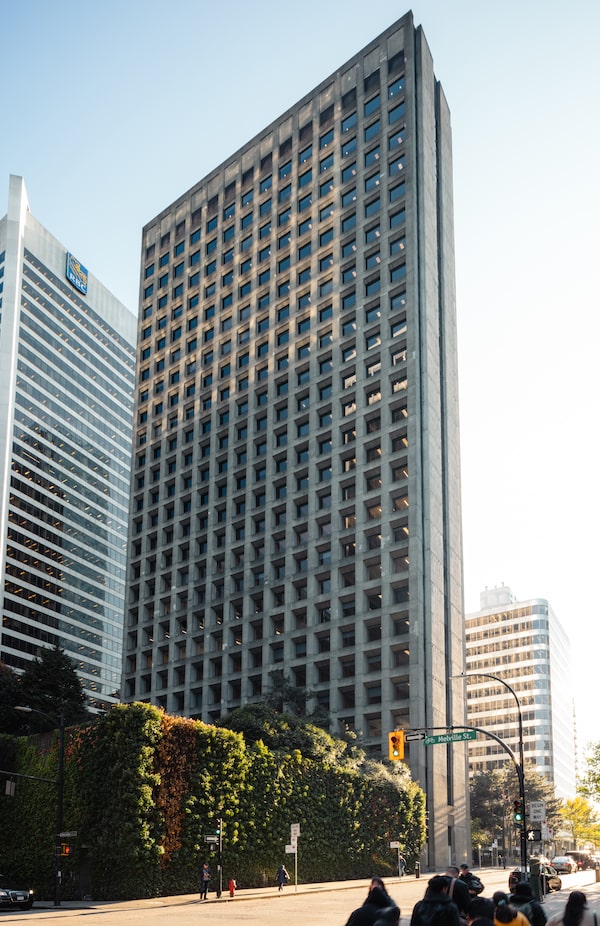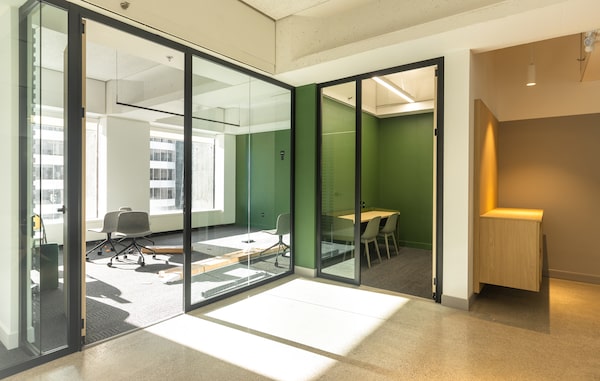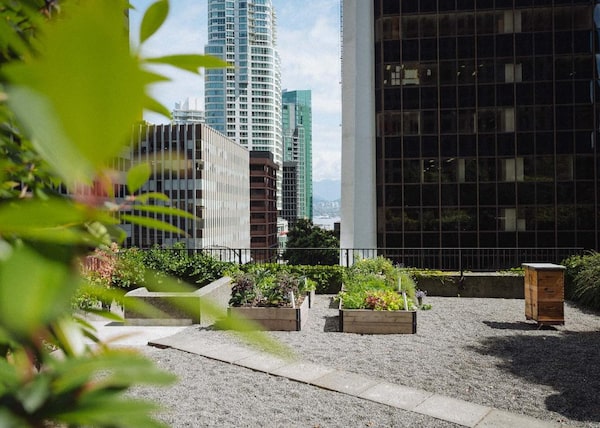
The owners of Vancouver’s iconic downtown office building, Arthur Erickson Place, aim to achieve zero-carbon certification with a retrofit that includes optimized HVAC controls, as well as heat pumps and new electric boilers.Ryan Broda
Vancouver’s landmark 26-storey Arthur Erickson Place was built in 1968, a time when energy and efficiency were rarely used in the same sentence.
Today, the downtown office tower, on the northeast corner of West Georgia and Thurlow streets, is getting a refit that will reduce the building’s carbon emissions by 97 per cent and achieve a Zero Carbon Building-Performance Standard certification from the Canada Green Building Council.
It’s an extreme case study of what is possible even with vintage commercial buildings, says Kit Milnes, vice-president of sustainability and resilience for KingSett Capital, which co-owns the iconic building, along with Crestpoint Real Estate Investments Ltd. and Reliance Properties Ltd.
“Every building is unique and the older it is, the more difficult, but there are always opportunities for significantly reducing carbon emissions,” he says.
KingSett has previously achieved zero-carbon certification for retrofits of Toronto’s Scotia Plaza towers at 40 King St. W. and 100 Yonge St., as well as the Royal York Hotel.
“In the past few years, new technology has created a range of opportunities for automating building operations that weren’t available just a few years ago,” Mr. Milnes says. “We can have one brain for the building that functions and controls everything.”

High-quality building performance data can also identify features of the building that don’t require immediate updates, such as the inset windows.Ryan Broda
Every building is unique and the older it is, the more difficult, but there are always opportunities for significantly reducing carbon emissions.
— Kit Milnes, vice-president of sustainability and resilience, KingSett Capital
Meanwhile, heat pumps are advancing quickly as replacements for natural gas-fired heating systems that are a major source of carbon emissions.
Sustainable mechanical upgrades of Arthur Erickson Place, named after its famed Canadian architect, include optimized HVAC controls as well as heat pumps and new electric boilers.
The changes aim to reduce the building’s total energy consumption by 40 per cent and the emissions reduction is the equivalent of removing approximately 140 gas-powered cars from the road each year, Mr. Milnes estimates.
The rethink started in 2019 when the owners acquired the former headquarters of forestry company MacMillan Bloedel Ltd., which had gained the nickname the Waffle Building for its deeply recessed square windows inset into tapered concrete walls.
An initial study of energy savings led to the goal of achieving zero net emissions of carbon by 2025. It’s part of a growing trend, says Brad White, president of SES Consulting in Vancouver, which planned the three-year decarbonization process of the 363,000-square-foot commercial building that began in 2022.
Even five years ago, cost saving through energy efficiency was the focus of building retrofits and carbon emissions elimination targets were mostly only being set for buildings in the public sector, Mr. White says.
“But now it is private-sector owners who are setting zero-carbon goals to keep their buildings competitive in this office market,” Mr. White says. “We have a lot of buildings trying to achieve 80 per cent or greater reductions with retrofits and changing mechanical systems.”

Improving the outdated systems will help the building achieve an estimated 40-per-cent reduction in overall energy consumption.Ryan Broda
“It’s a matter of looking at what contributes most to carbon emissions,” he adds. “And in most cases, the biggest reduction can be achieved by replacing gas-fired heating with electric heat pumps and boilers,” particularly in British Columbia where electricity generation emissions are minimal.
The old heating system at Arthur Erickson Place depended on its original trio of natural gas-fired boilers that analysis determined were overbuilt for the needs of the building.
Another essential element is installing smart control systems to use the equipment as efficiently as possible, Mr. White adds.
“Big commercial heat pumps are expensive, so you really don’t want to oversize them. That’s why we want to start with quality operational data and not just models to see how the building is performing.”
Weighing costs and benefits is also essential in setting carbon-reduction goals, Mr. Milnes says. “You have to be mindful of the capital you are putting in and what benefit it is going to have. Ideally the equipment you need to replace is nearing the end of its usable life and due for replacement.”
There’s little return in replacing relatively new mechanical systems that can last for 20 to 30 years if they are managed well, he says.
High-quality building performance data can also identify features of the building that are not candidates for immediate replacement. For instance, the windows of Arthur Erickson Place are still in good condition.
“There is zero payback in ripping out a building envelope and putting a new one in just for the sake of trying to save a few cents per square foot on energy consumption,” Mr. Milnes says.
But if the glass is leaking and near a point of failure, he says, “you need to do the work to protect your investment on energy efficiency.”
Mr. Milnes says he’s “blown away” by the amount of new technology appearing on the commercial real estate market.
“Everything we need to eliminate carbon emissions is mostly available on the market already,” he says. “It’s a matter of having the right team in place [with] the experience and will to be innovative and challenge the status quo.”